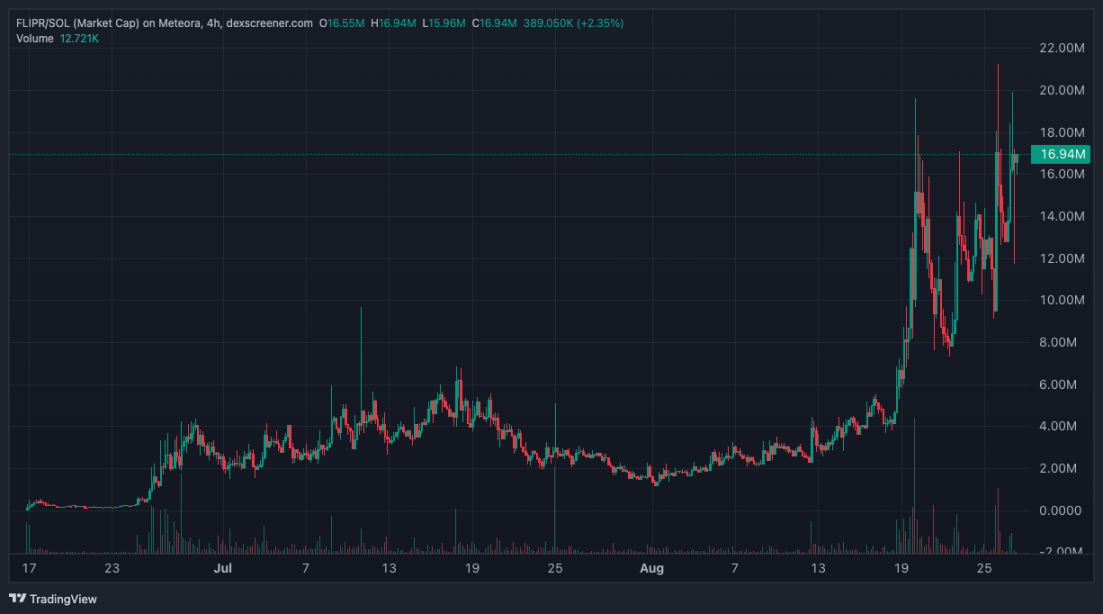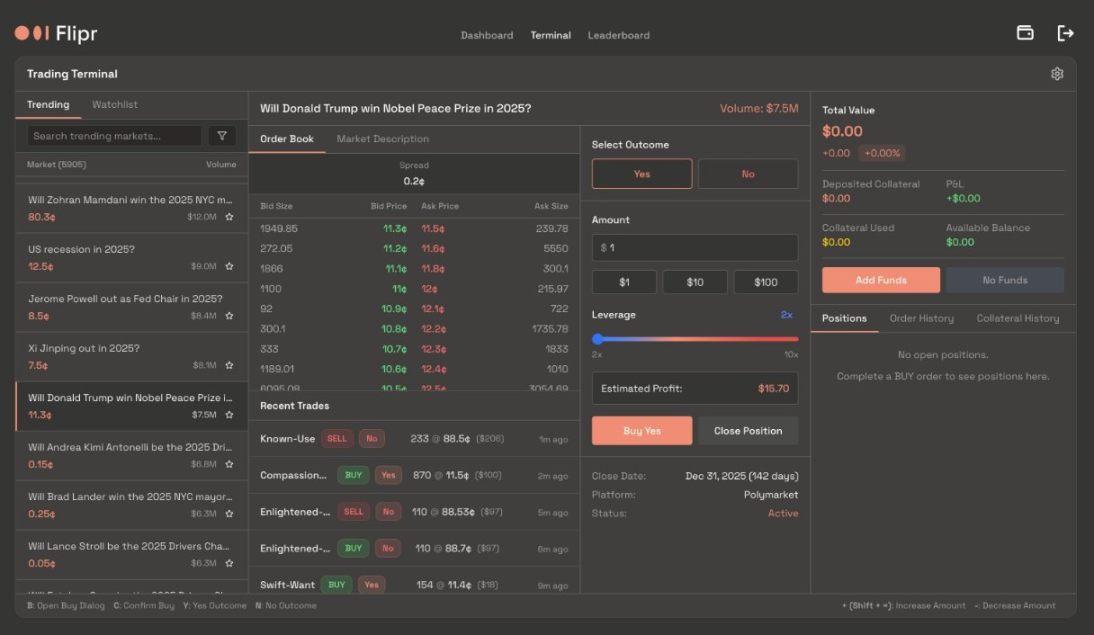What is Flipr, a prediction trading robot?
From late June through late August this year, Flipr’s price performance was nothing short of remarkable. Just two months ago, its market capitalization was under $200,000 and attracted little attention. By August 27, the project’s market cap had surged to a peak of $24 million—a more than 100-fold increase—jumping 16 times in August alone.

So, what is Flipr? In short, it isn’t a new prediction market itself—it’s a social entry point for prediction markets. Unlike Polymarket or Kalshi, which require separate platforms and dedicated interfaces. Flipr takes a streamlined approach by integrating directly into the social platform X.
What Is Flipr: The Social Layer of Prediction Markets
Flipr officially launched in July 2025. Its key access point is Fliprbot, a trading bot running on the X platform. Unlike traditional prediction markets that require you to visit a separate website, browse market lists, connect a wallet, then place a bet, Flipr compresses the entire experience into a single social conversation.
On X, users can simply mention @fliprbot or send a direct message with a plain-language command—such as “Will Donald Trump win Nobel Peace Prize in 2025?”—along with the direction and amount of the bet, to execute a trade. Bet information instantly appears in the feed as a social post, becoming an event that others can copy, share, or challenge. Flipr fuses trading with posting, making every bet visible to everyone.

To lower the barrier for newcomers, Flipr has integrated Privy’s account system and introduced features such as leveraged trading and take-profit/stop-loss options. Betting no longer requires users to switch platforms. Instead, it naturally extends the conversation. Flipr even supports group chats and community embedding—group admins can instantly create markets in a chat, and users can bet while chatting, making predictions as effortless as sharing a meme or sticker.
This design logic is straightforward. Traditional prediction markets function as tools for professional speculators, while Flipr aims to make trading part of everyday social interaction. Rather than competing directly with Polymarket or Kalshi, Flipr positions itself at the user engagement front end. Polymarket and Kalshi provide market depth and regulatory compliance, while Flipr delivers visibility and virality. This creates a complementary dynamic across the prediction market landscape. Flipr serves as an amplifier, bringing specialized trading to the broader social scene.
This product thesis fuels its viral reach. Bets are transformed into shareable, commentable, and debate-ready posts—opinion and capital risk-taking merges in the same space, amplifying trade visibility across the entire social network. Flipr converts prediction markets from a niche tool into viral content. The platform’s rapid rise is largely thanks to this inherent shareability.
On July 7, Flipr launched the Mindshare Mining campaign, which ran for six weeks and distributed a total of 10 million FLIPR tokens as rewards.
Unlike typical “trade mining” programs that simply reward trading volume, Flipr designed a more sophisticated scoring system aimed at blending betting activity with social engagement. Points are calculated on five dimensions: higher trading volume earns more points—that’s the simplest part; posting time matters too, with early-week posts weighted more heavily to incentivize first-movers; consecutive posting is rewarded; anti-spam mechanisms deduct points for excessive posting, so low-value content doesn’t overwhelm the community; and finally, user engagement—likes, comments, shares—directly counts toward your overall score.
The Prediction Market Landscape and Flipr’s Prospects
Flipr’s rapid rise is logical in the prediction market sector’s current context. Over the past year, Polymarket and Kalshi have demonstrated the scale and potential of prediction markets, but neither has issued a token—so there’s no asset for capital to rally around. As a result, risk-seeking capital has naturally gravitated toward Flipr, a low-cap project with a compelling sector narrative.
Meanwhile, the spotlight on prediction markets is intensifying. Polymarket’s total transaction volume surpassed $9 billion in 2024, reaching $2.6 billion in a single month during the U.S. presidential election, firmly establishing it as the leading crypto-native prediction platform. Kalshi, with CFTC approval, rapidly expanded its regulatory footing, posting $2 billion in volume in 2024 and achieving a $2 billion valuation after 2025 fundraising. Over the last two years, the sector has evolved from a fringe experiment to a fast-growing niche.
Officially, Flipr has already integrated with Polymarket and will soon connect to Kalshi. Rather than competing on liquidity or compliance, Flipr prioritizes user experience at the front end. The X platform boasts 150 million daily active users, already engaged in events and emotional expression. By embedding prediction markets here and overlapping bets with posts, Flipr lowers the barrier for participation. For Polymarket and Kalshi, this social layer could be the missing link.
Even more significantly, Ethereum co-founder Vitalik Buterin has publicly championed prediction markets on numerous occasions. For the last two years, Vitalik has been a leading proponent, repeatedly highlighting the role of prediction markets in “information accuracy” and “cognitive correction.” He points out that in token governance, poor choices have little consequence. But in prediction markets, bad calls lead to real financial losses. This mechanism forces rational participation and often means market-set probabilities are more accurate than media sentiment. Personally, Vitalik says prediction markets help him stay level-headed—shielded from social media’s emotional amplifications—and provide real alerts when major events occur. He views them as social technology that enhances collective rationality and aligns with blockchain’s open governance ethos.
Vitalik also frequently discusses the application potential and future improvements for prediction markets. He notes most lack interest compensation, limiting appeal as hedging tools; if solved, these markets could see significant growth in hedging use cases and trading volume. He also envisions AI-driven prediction markets powering new solutions for community fact-checking, DAO arbitration, and even automated market-making. For instance, he imagines prediction markets embedded in X’s “Community Notes,” with AI and micro-betting incentives accelerating truth verification. To Vitalik, prediction markets and Community Notes are flagship social cognition technologies for the 2020s—both built on open participation, not elite control, and crucial for decentralized governance.
Flipr’s key challenge is whether it can transform this short-term momentum into long-term, sustainable growth. When the Mindshare Mining incentive ends, activity could drop unless a new model keeps engagement high. If the Kalshi integration materializes, Flipr could become the social front end for compliant prediction trading in the U.S. market, unlocking new growth opportunities.
Disclaimer:
- This article is reprinted from [Foresight News] with copyright held by the original author [ChandlerZ, Foresight News]. If you have any concerns regarding this reprint, please contact the Gate Learn team, and we will address it promptly in accordance with our established procedures.
- Disclaimer: The views and opinions expressed in this article are solely those of the author and do not constitute investment advice.
- Other language versions of this article are translated by the Gate Learn team. You may not reproduce, distribute, or plagiarize these translations without proper reference to Gate.
Related Articles

Solana Need L2s And Appchains?

The Future of Cross-Chain Bridges: Full-Chain Interoperability Becomes Inevitable, Liquidity Bridges Will Decline

Sui: How are users leveraging its speed, security, & scalability?

Navigating the Zero Knowledge Landscape

What is Tronscan and How Can You Use it in 2025?
